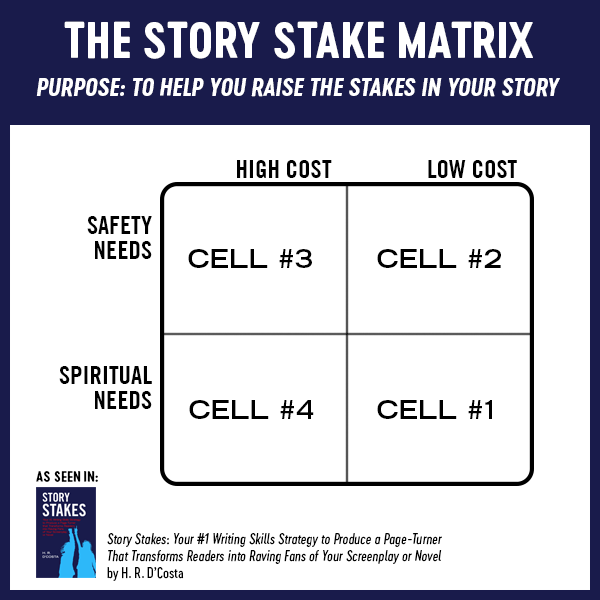Let’s start with the basics.
What are story stakes anyway?
Simply put, they’re the negative consequences of failure. If your protagonist doesn’t achieve his goal, bad things will happen.
Very bad things.
(Of course, the definition of “bad” varies between genres.)
That was easy.
A slightly more difficult question to answer is this: why do story stakes matter?
Well, stakes give readers a reason to care about what happens in your story.
If your protagonist lacks motivation, everything that happens–even the really cool stuff like explosions, pratfalls, and banter–is pointless.
If audiences sense that your protagonist is engaging in pointless activity just for the sake of their entertainment, no matter how entertaining it might be, they will tune out, disengage, and stop reading.
You can kiss that huge spec sale or a five-star review of your ebook good-bye.
On the other hand, when audiences are aware of the stakes, they’ll be under tension. They’ll be worried about your protagonist.
They won’t be able to put down your story because the ONLY way to relieve that tension is to keep on turning the pages till they’ve reached THE END.
That’s one reason stakes are important. There’s another too:
If you maximize the power of your story stakes and use them to deliver an intense emotional experience, when readers are done with your screenplay or novel, they won’t reach for another script or book in their TBR pile.
Nope.
Because emotion is the prime standard by which stories are judged, these readers will first recommend your story to everyone they know.
With such passionate advocates in your corner, you’ll be well on your way to a long-lasting storytelling career.
So, now that we covered what story stakes are and why they’re so important, let’s examine three questions which will help you use stakes to maximum advantage:
Story Stake Question #1: Have I established the stakes during the beginning of my story?
This question may seem like an obvious one to include, but you’d be surprised at how many writers get so caught up with the coolness of their premise that they forget to ask themselves this very thing!
Look at NIGHT AT THE MUSEUM, for example: a night watchman at the Museum of Natural History discovers that, after the sun sets, the museum exhibits all come to life.
Now, I don’t know about your taste in movies. You may think NIGHT was an idiotic film. (I, for one, was annoyed by the extended antics with the monkey, although, as a whole, I think the movie provided decent family entertainment.)
But, I think we can both agree that it’s a high-concept premise, the kind that makes a studio executive’s eyes light up with dollar signs.
So, let’s say you had developed a saleable concept like that. And you were really having a blast coming up with lots of hilarious ways for the museum exhibits to wreak havoc for Larry.
Like the stunt with Rexy, the dinosaur skeleton who liked to play fetch with a giant bone, as if he had been a cuddly puppy and not a carnivorous reptile. In a nice touch, the bone, by the way, was taken from Rexy’s own body!
As fans of screenwriter Blake Snyder might say, you nailed the “fun and games.” You’ve come up with good stuff. But it’s not enough.
Here’s why: Larry is way out of his league. This museum job is awful. Technically, Larry should quit. At one point, he does!
Audiences are going to quickly come to that same conclusion, and then, as a result, disengage from your story. This will happen whether they really like Larry, think that he’s cool, or feel sorry for him.
But if Larry does quit his job as the night watchman (and never tries, as he eventually does in the film, to reclaim the position), then your story is over.
There’s no more unruly museum exhibits to contend with. Your potential for comedic set pieces has been dramatically reduced.
Your high-concept premise has gone out the window.
This, of course, all changes if you provide Larry–and audiences–with a reason to stay, a reason why Larry cannot walk away.
Enter stakes of livelihood.
These stakes are especially effective when combined with any of the following:
- the protagonist has invested significant resources to achieve his current position
- the protagonist had to fight against parental disapproval or societal constraints to get where he is
- the position itself is rare and difficult to obtain
- the position is inextricably connected to the protagonist’s self-esteem
- the protagonist is unlikely to find future employment elsewhere
In the case of NIGHT AT THE MUSEUM, the film really shined because it linked Larry’s continued employment with his relationship to his son, Nicky.
Larry has to keep this hellacious job. Otherwise, Nicky might conclude that his dad is a loser.
Those are great stakes.
They make it easy to buy into the idea that Larry would do whatever it took to tame the unruly museum exhibits and impress his son. That’s something that audiences can understand, relate to, and, most importantly, root for.
In other words, the stakes gave audiences a reason to care about what happens, to fully and wholeheartedly invest in Larry’s adventures.
Your want them to feel the same way about whatever your protagonist is pursuing in your story.
So before you design your action stunts and comedy gags, make sure you first determine why they matter
Make sure you’ve established the central stakes of your story.
In NIGHT AT THE MUSEUM, during the first act, audiences spend a lot of time with Nicky. They understand the dynamics of that father-son relationship.
As the story progresses, it will build on that groundwork…
…which brings me to the second crucial question you need to ask yourself about your protagonist’s motivation:
Story Stake Question #2: Have I reminded audiences about the stakes?
Stakes usually do not fall into the category of “set it and forget it.”
To maintain audience interest and emotional investment, you need to periodically remind them why your story matters.
In other words, once you establish the stakes in Act One, you need remind audiences about them throughout Act Two, so that they will be intensely involved in what transpires during Act Three.
There are several different reminder strategies at your disposal. Here’s one of my favorites: the surrogacy reminder.
To implement it, you basically show the negative consequences of failure happening to another character—not the stakes.
As a comedic example, let’s look at PIRATES OF THE CARIBBEAN 2. Bootstrap Bill warns Jack that the monstrous Kraken is coming for Jack and The Black Pearl. Soon thereafter, a fisherman finds Jack’s cap floating in the water.
The cap acts like a homing beacon, luring the Kraken to the unfortunate fisherman’s boat. The monstrous beast destroys the vessel—and all onboard—instantly.
Because audiences see what Jack fears happening to other characters, the stakes feel more real and intense than if audiences didn’t have this experience at all.
When you’re evaluating whatever reminder strategy you choose to employ, make sure you take momentum into account.
The actions a protagonist takes in order to stop his antagonist have a strong forward trajectory. Stakes, on the other hand, usually don’t have that kind of energy. They tend to be suspended in stasis, waiting for the antagonist to make his next move.
So when you switch from the protagonist’s actions in order to focus on the stakes, your story momentum can seriously stall.
Usually, the tradeoff will be worth it. The emotional resonance produced by the reminders more than makes up for their effect on momentum. Even so, you should always conduct a cost-benefit analysis just to make sure.
And now, onto your final critical question about story stakes…
Story Stake Question #3: Have I raised the stakes?
It’s time to address a salient point we haven’t touched on yet: the stakes can’t remain the same throughout your story.
To sustain audience involvement, the negative consequences of failure have to grow.
They have to escalate.
Here’s one simple method you can use to immediately raise the stakes in your story:
Add another set of stakes to whatever’s already present.
To put it another way, to make audiences care more about what happens in your screenplay or novel, give them more to care about.
The most common time to do this is at the midpoint, when audience interest has the potential to wane. But you can prop that interest right up by adding another set of stakes to the story, making the negative consequences of failure even worse.
A great example can be found in BACK TO THE FUTURE. At first, when Marty McFly ventures back to the year 1955, the negative consequences are bad—but not that bad.
Sure, he’s trapped in a different time period. He wants to return to his old life in 1985, to his cute girlfriend.
But as far as stakes of freedom go, these are pretty low-key. Marty may be unhappy about the situation, but hey, he’s not behind bars! He’s still got free will. He’s still alive.
That possibility, however, begins to fade—in front of Marty’s very own eyes—right around the midpoint. When Marty shows Doc a photo of Marty’s family, it’s revealed that Marty’s brother has been partially erased from the picture.
As Doc concludes, if Marty doesn’t find a way to get his parents to fall in love, Marty will cease to exist.
Cha-ching!
The stakes just got higher.
Keep Readers Enthralled with Story Stakes & Sell Your Screenplay or Novel
Master stakes, and you can build success right into the core of your story.
The tension they produce is what keeps readers up at night, unable to put down your script or novel. The emotional intensity they generate paves the way for stellar word-of-mouth recommendations.
If you’re writing a screenplay, both of these results will lead to selling your spec, or, at the very least, landing on Hollywood’s radar.
If you’re publishing a novel, these results will lead to rising up the bestseller ranks on Amazon or Apple.

In this brief article, we’ve only covered a few ways to harness the power of story stakes to your advantage.
If you’d like to learn more, please check out my writing guide, Story Stakes: Your #1 Writing Skills Strategy to Produce a Page-Turner that Transforms Readers into Raving Fans of Your Screenplay or Novel.
It will teach you about:
- 11 kinds of story stakes which increase tension and reader engagement
- 8 modulating factors you can use to elicit extra emotion from your readers
- how to use stakes to craft a premise with more commercial appeal
- more surefire strategies to raise the stakes–even when they’re already high to begin with!
Let’s take a closer look at that last item for a second.
In later chapters in Story Stakes, you’ll discover the story stake matrix.
Made of four cells, it’s defined by two parameters: (1) type of story stake (the 11 story stakes are divided into categories) and (2) the cost of participation (it’s either high or low, depending on the kind of danger associated with the action your protagonist takes to achieve his goal).

Here’s why the matrix is valuable: if you understand how a story transitions from one cell to another, you’ll know exactly how to raise the stakes in your story.
Download the ebook instantly or buy the paperback (free shipping with Amazon Prime):
Amazon (US) | Amazon (international)
Download the ebook instantly from: Apple | Kobo | Smashwords
Finish line by Upendra Kanda




















